NICHIA UV LED NCSU033C U365nm is Pb-free reflow Soldering application, built-in EDS protection Device, RoHS compliant.
model no. :
NCSU033C U365nmBrand:
DSXUVport of dispatch :
SHENZHENPayment :
T/Toriginal region :
CHINALead Time :
The Same DayNICHIA UV LED NCSU033C U365nm plays a significant role in leak detection of air-conditioner refrigerant, engine lubricating ole, etc.. Also, it can fluorescence observation of mineral, fluorescence penetrant flaw detaction, etc..
SPECIFICATIONS
(1) Absolute Maximum Ratings
Item
Symbol
Absolute Maximum Rating
Unit
Forward Current
IF
700
mA
Pulse Forward Current
IFP
1000
mA
Allowable Reverse Current
IR
85
mA
Power Dissipation
PD
3.08
W
Operating Temperature
Topr
-10~85
°C
Storage Temperature
Tstg
-40~100
°C
Junction Temperature
TJ
130
°C
* Absolute Maximum Ratings at T S =25°C.
* I FP conditions with pulse width ≤10ms and duty cycle ≤10%.
(2) Initial Electrical/Optical Characteristics
|
Item |
Symbol |
Condition |
Type |
Max |
Unit |
|
Forward Voltage |
VF |
IF =500mA |
3.8 |
- |
V |
|
Radiant Flux |
Φe |
IF =500mA |
750 |
- |
mW |
|
Peak Wavelength |
λp |
IF =500mA |
365 |
- |
nm |
|
Spectrum Half Width |
Δλ |
IF =500mA |
9.0 |
- |
nm |
|
Thermal Resistance |
RθJS |
- |
4.4 |
7.3 |
°C/W |
RANKS
|
Item |
Rank |
Min |
Max |
Unit |
|
Forward Voltage
|
H |
4.0 |
4.4 |
V
|
|
M |
3.6 |
4.0 |
||
|
L |
3.2 |
3.6 |
||
|
Radiant Flux |
P6d22 |
870 |
950 |
mW |
|
P6d21 |
800 |
870 |
||
|
P5d22 |
730 |
800 |
||
|
P5d21 |
670 |
730 |
||
|
P4d22 |
610 |
670 |
||
|
P4d21 |
560 |
610 |
||
|
Peak Wavelength |
U365 |
360 |
370 |
nm |
* Ranking at T S =25°C.
* Forward Voltage Tolerance: ±0.05V
* Radiant Flux Tolerance: ±6%
* Peak Wavelength Tolerance: ±3nm
* LEDs from the above ranks will be shipped. The rank combination ratio per shipment will be decided by Nichia.
OUTLINE DIMENSIONS
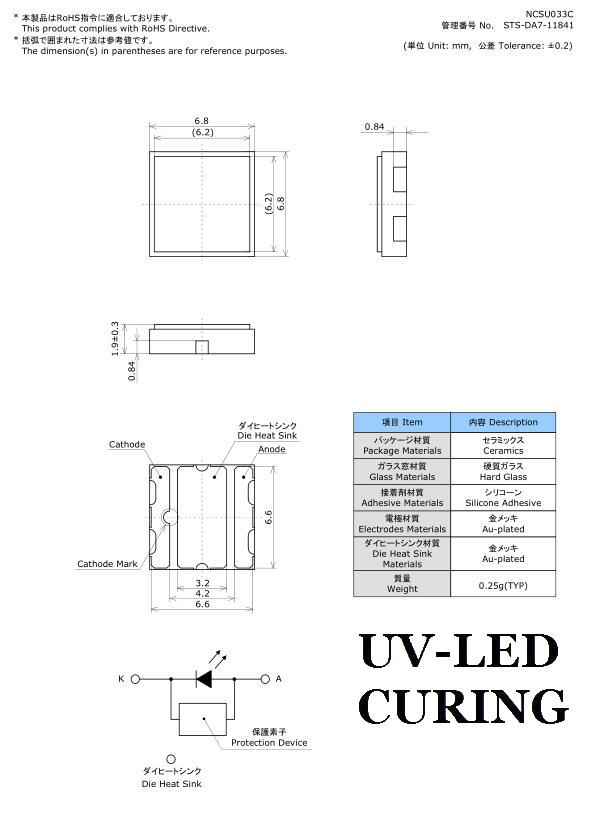
RELIABILITY
(1) Tests and Results
|
Test |
Reference Standard |
Test Conditions |
Test Duration |
Failure Criteria # |
Units Failed/Tested |
|
Resistance to Soldering Heat(Reflow Soldering) |
JEITA ED-4701 300 301 |
T sld =260°C, 10sec, 2reflows, Precondition: 30°C, 70%RH, 168hr |
|
#1 |
0/10 |
|
Thermal Shock |
|
-40°C to 100°C, 15min dwell |
100cycles |
#1 |
0/10 |
|
High Temperature Storage |
JEITA ED-4701 200 201 |
T A =100°C |
1000hours |
#1 |
0/10 |
|
Low Temperature Storage |
JEITA ED-4701 200 202 |
T A =-40°C |
1000hours |
#1 |
0/10 |
|
Room Temperature Operating Life |
|
T A =25°C, I F =700mA |
1000hours |
#1 |
0/10 |
|
High Temperature Operating Life |
|
T A =85°C, I F =300mA |
1000hours |
#1 |
0/10 |
|
Temperature Humidity Operating Life |
|
60°C, RH=90%, IF =450mA |
500hours |
#1 |
0/10 |
|
Low Temperature Operating Life |
|
T A =-10°C, I F =500mA |
1000hours |
#1 |
0/10 |
|
Vibration |
JEITA ED-4701 400 403 |
200m/s 2 , 100~2000~100Hz, 4cycles, 4min, each X, Y, Z |
48minutes |
#1 |
0/10 |
|
Electrostatic Discharges |
JEITA ED-4701 300 304 |
HBM, 2kV, 1.5kΩ, 100pF, 3pulses, alternately positive or negative |
|
#1 |
0/10 |
NOTES:
1) R θJA ≈35°C/W
2) Measurements are performed after allowing the LEDs to return to room temperature.
(2) Failure Criteria
|
Criteria # |
Items |
Conditions |
Failure Criteria |
|
#1 |
Forward Voltage(VF ) |
IF =500mA |
>Initial value×1.1 |
|
Radiant Flux(ΦE ) |
IF =500mA |
<Initial value×0.7 |
CAUTIONS
(1) Storage
|
Conditions |
Temperature |
Humidity |
Time |
|
|
Storage |
Before Opening Aluminum Bag |
≤30°C |
≤90%RH |
Within 1 Year from Delivery Date |
|
After Opening Aluminum Bag |
≤30°C |
≤70%RH |
≤168hours |
|
|
Baking |
65±5°C |
- |
≥24hours |
|
● Product complies with JEDEC MSL 3 or equivalent. See IPC/JEDEC STD-020 for moisture-sensitivity details.
● Absorbed moisture in LED packages can vaporize and expand during soldering, which can cause interface delamination and result
in optical performance degradation. Products are packed in moisture-proof aluminum bags to minimize moisture absorption
during transportation and storage. Included silica gel desiccants change from blue to red if moisture had penetrated bags.
● After opening the moisture-proof aluminum bag, the products should go through the soldering process within the range of the
conditions stated above. Unused remaining LEDs should be stored with silica gel desiccants in a hermetically sealed container,
preferably the original moisture-proof bags for storage.
● After the “Period After Opening” storage time has been exceeded or silica gel desiccants are no longer blue, the products should
be baked. Baking should only be done once.
● Although the leads or electrode pads (anode and cathode) of the product are plated with gold, prolonged exposure to a corrosive
environment might cause the gold plated the leads or electrode pads to tarnish, and thus leading to difficulties in soldering. If
unused LEDs remain, they must be stored in a hermetically sealed container. Nichia recommends using the original
moisture-proof bag for storage.
● Do not use sulfur-containing materials in commercial products. Some materials, such as seals and adhesives, may contain sulfur.
The contaminated plating of LEDs might cause an open circuit. Silicone rubber is recommended as a material for seals. Bear in
mind, the use of silicones may lead to silicone contamination of electrical contacts inside the products, caused by low molecular
weight volatile siloxane.
● To prevent water condensation, please avoid large temperature and humidity fluctuations for the storage conditions.
● Do not store the LEDs in a dusty environment.
● Do not expose the LEDs to direct sunlight and/or an environment where the temperature is higher than normal room temperature.
(2) Directions for Use

● This product should be operated using forward current. Ensure that the product is not subjected to either forward or reverse
voltage while it is not in use. In particular, subjecting it to continuous reverse voltage may cause migration, which may cause
damage to the LED die. When used in displays that are not used for a long time, the main power supply should be switched off
for safety.
● It is recommended to operate the LEDs at a current greater than 10% of the sorting current to stabilize the LED characteristics.
● Ensure that excessive voltages such as lightning surges are not applied to the LEDs.
● For outdoor use, necessary measures should be taken to prevent water, moisture and salt air damage.
● This product also emits visible light. If the LEDs are used as a light source in applications such as sensors, etc. take into
consideration the emission that is in the visible light spectrum.
● If this product is stored and/or used constantly under high humidity conditions, it may accelerate the deterioration of the die; this
may cause the radiant flux to decrease. If the LEDs are stored and/or used under these conditions, sufficient verification must be
done prior to use to ensure there are no issues for the chosen application.
● Do not design this LED into applications where condensation may occur. If the LEDs are stored/operated in these environments,
it may cause issues (e.g. current leaks that cause the radiant flux to decrease).
(3) Handling Precautions
● Do not handle the LEDs with bare hands as it will contaminate the LED surface and may affect the optical characteristics: it might
cause the LED to be deformed and/or the wire to break, which will cause the LED not to illuminate.
● When handling the product with tweezers, be careful not to apply excessive force to the glass. Otherwise, The glass can be cut,
chipped, delaminate or deformed, causing wire-bond breaks and catastrophic failures.
● Dropping the product may cause damage.
● Do not stack assembled PCBs together. Failure to comply can cause the glass portion of the product to be cut, chipped,
delaminated and/or deformed. It may cause wire to break, leading to catastrophic failures.
(4) Design Consideration
● PCB warpage after mounting the products onto a PCB can cause the package to break. The LED should be placed in a way to
minimize the stress on the LEDs due to PCB bow and twist.
● The position and orientation of the LEDs affect how much mechanical stress is exerted on the LEDs placed near the score lines.
The LED should be placed in a way to minimize the stress on the LEDs due to board flexing.
● Board separation must be performed using special jigs, not using hands.
● If an aluminum PCB is used, customer is advised to verify the PCB with the products before use. Thermal stress during use can
cause the solder joints to crack.
(5) Electrostatic Discharge (ESD)
● The products are sensitive to static electricity or surge voltage. ESD can damage a die and its reliability. When handling the
products, the following measures against electrostatic discharge are strongly recommended:
Eliminating the charge
Grounded wrist strap, ESD footwear, clothes, and floors
Grounded workstation equipment and tools
ESD table/shelf mat made of conductive materials
● Ensure that tools, jigs and machines that are being used are properly grounded and that proper grounding techniques are used
in work areas. For devices/equipment that mount the LEDs, protection against surge voltages should also be used.
● If tools or equipment contain insulating materials such as glass or plastic, the following measures against electrostatic discharge
are strongly recommended:
Dissipating static charge with conductive materials
Preventing charge generation with moisture
Neutralizing the charge with ionizers
● The customer is advised to check if the LEDs are damaged by ESD when performing the characteristics inspection of the LEDs in
the application. Damage can be detected with a forward voltage measurement at low current (≤1mA).
● ESD damaged LEDs may have current flow at a low voltage.
Failure Criteria: V F <2.0V at I F =0.5mA
(6) Thermal Management
● Proper thermal management is an important when designing products with LEDs. LED die temperature is affected by PCB thermal
resistance and LED spacing on the board. Please design products in a way that the LED die temperature does not exceed the
maximum Junction Temperature (T J ).
● Drive current should be determined for the surrounding ambient temperature (T A ) to dissipate the heat from the product.
● The following equations can be used to calculate the junction temperature of the products.
1) T J =T A +R θJA ・W 2) T J =T S +R θJS ・W
*T J =LED junction temperature: °C
T A =Ambient temperature: °C
T S =Soldering temperature (die heat sink): °C
R θJA =Thermal resistance from junction to ambient: °C/W
R θJS =Thermal resistance from junction to T S measurement point: °C/W
W=Input power(I F ×V F ): W
T S Measurement Point
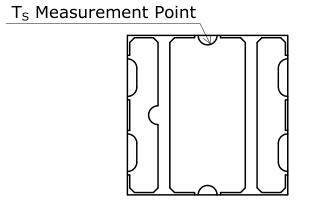
(7) Cleaning
● The LEDs should not be cleaned. Other cleaning agents except for Freon solvent should be tested prior to use whether they will
not affect the package and the glass. Please note that Freon solvent is prohibited worldwide.
● Ultrasonic cleaning is not recommended since it may have adverse effects on the LEDs depending on the ultrasonic power and how
LED is assembled. If ultrasonic cleaning must be used, the customer is advised to make sure the LEDs will not be damaged prior
to cleaning.
(8) Eye Safety
● In 2006, the International Electrical Commission (IEC) published IEC 62471:2006 Photobiological safety of lamps and lamp
systems, which added LEDs in its scope. On the other hand, the IEC 60825-1:2007 laser safety standard removed LEDs from its
scope. However, please be advised that some countries and regions have adopted standards based on the IEC laser safety
standard IEC 60825-1:20112001, which still includes LEDs in its scope. Most of Nichia's LEDs can be classified as belonging into
either the Exempt Group or Risk Group 1. High-power LEDs, that emit light containing blue wavelengths, may be classified as Risk
Group 2. Please proceed with caution when viewing directly any LEDs driven at high current, or viewing LEDs with optical
instruments which may greatly increase the damages to your eyes.
● Viewing a flashing light may cause eye discomfort. When incorporating the LED into your product, please be careful to avoid
adverse effects on the human body caused by light stimulation.
● The products are UV light LEDs, and radiate intense UV light during operation. Since UV light can be harmful to eyes, do NOT look
directly into the UV light, even through an optical instrument. In case of the light reflection, UV protective glasses are required to
use in order to avoid damage by the light.
● Ensure that appropriate warning signs/labels are provided both on each of the systems/applications using the UV LEDs, in all
necessary documents (e.g. specification, manual, catalogs, etc.), and on the packaging materials.
(9) Miscellaneous
● Nichia warrants that the discrete LEDs will meet the requirements/criteria as detailed in the Reliability section within this
specification. If the LEDs are used under conditions/environments deviating from or inconsistent with those described in this
specification, the resulting damage and/or injuries will not be covered by this warranty.
● Nichia warrants that the discrete LEDs manufactured and/or supplied by Nichia will meet the requirements/criteria as detailed in
the Reliability section within this specification; it is the customer’s responsibility to perform sufficient verification prior to use to
ensure that the lifetime and other quality characteristics required for the intended use are met.
● The applicable warranty period is one year from the date that the LED is delivered. In the case of any incident that appears to be
in breach of this warranty, the local Nichia sales representative should be notified to discuss instructions on how to proceed while
ensuring that the LED in question is not disassembled or removed from the PCB if it has been attached to the PCB. If a breach of
this warranty is proved, Nichia will provide the replacement for the non-conforming LED or an equivalent item at Nichia’s
discretion. FOREGOING ARE THE EXCLUSIVE REMEDIES AVAILABLE TO THE CUSTOMER IN RESPECT OF THE BREACH OF THE
WARRANTY CONTAINED HEREIN, AND IN NO EVENT SHALL NICHIA BE RESPONSIBLE FOR ANY INDRECT, INCIDENTAL OR
CONSEQUENTIAL LOSSES AND/OR EXPENSES (INCLUDING LOSS OF PROFIT) THAT MAY BE SUFFERED BY THE CUSTOMER
ARISING OUT OF A BREACH OF THE WARRANTY.
● NICHIA DISCLAIMS ALL OTHER WARRANTIES, EXPRESS OR IMPLIED, INCLUDING THE IMPLIED WARRANTIES OF
MERCHANTABILITY AND FITNESS FOR A PARTICULAR PURPOSE.
● This LED is intended to be used for general lighting, household appliances, electronic devices (e.g. mobile communication
devices); it is not designed or manufactured for use in applications that require safety critical functions (e.g. aircraft, automobiles,
combustion equipment, life support systems, nuclear reactor control system, safety devices, spacecraft, submarine repeaters,
traffic control equipment, trains, vessels, etc.). If the LEDs are planned to be used for these applications, unless otherwise
detailed in the specification, Nichia will neither guarantee that the LED is fit for that purpose nor be responsible for any resulting
property damage, injuries and/or loss of life/health. This LED does not comply with ISO/TS 16949 and is not intended for
automotive applications.
● The customer will not reverse engineer, disassemble or otherwise attempt to extract knowledge/design information from the LED.
● All copyrights and other intellectual property rights in this specification in any form are reserved by Nichia or the right holders who
have granted Nichia permission to use the content. Without prior written permission from Nichia, no part of this specification may
be reproduced in any form or by any means.
● Both the customer and Nichia will agree on the official specifications for the supplied LEDs before any programs are officially
launched. Without this agreement in writing (i.e. Customer Specific Specification), changes to the content of this specification
may occur without notice (e.g. changes to the foregoing specifications and appearance, discontinuation of the LEDs, etc.).
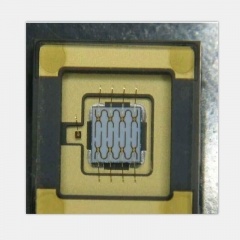 High Power UV-LED NVSU333A U365nm 18.9W 3640mW/cm2
High Power UV-LED NVSU333A U365nm 18.9W 3640mW/cm2
NVSU333A UV-LED is widely used in high precision curing, ink curing (printing), bill checker etc. It's also the best way to solidify UV glue.
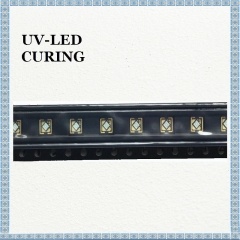 NICHIA UV LED NVSU233B U365nm
NICHIA UV LED NVSU233B U365nm
NICHIA UV LED NVSU233B U365nm is most applied in UV curing, splicing, UV glue, and UV prinying ink curing.
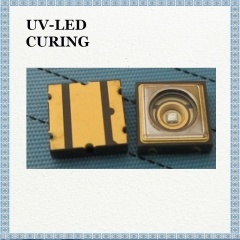 NICHIA NCSU033B 365nm UV LED
NICHIA NCSU033B 365nm UV LED
NICHIA NCSU033B 365nm UV LED can be used for criminal investigation, such as the observation of fingerprint, bloodstain, etc., mineral fluorescence observation, oil cleaning observation, and so on.
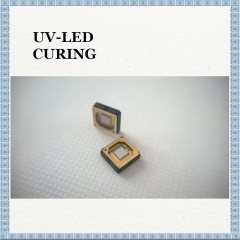 SVC CUN6GF1A UV 365nm 5W High Radiant Flux 1300mW
SVC CUN6GF1A UV 365nm 5W High Radiant Flux 1300mW
The applications of SVC CUN6GF1A UV 365nm 5W High Radiant Flux 1300mW are UV curing, printing, coating, adhesive, counterfeit dection/security, UV torch, fluorescence, photegraphy, dental curing, crime inspection, oil leak detection.
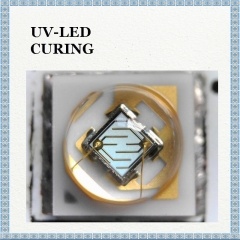 High Power NICHIA UV LED NCSU276A U365nm for UV Curing
High Power NICHIA UV LED NCSU276A U365nm for UV Curing
NICHIA UV LED NCSU276A U365nm requires unique and delicate production process. NICHIA places strict controls from wafer manufacturing to final inspection.
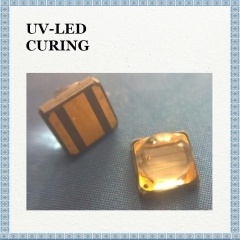 SVC CUN6GB1A UV 365nm LED View Angle 55deg 1400mW Quartz Glass
SVC CUN6GB1A UV 365nm LED View Angle 55deg 1400mW Quartz Glass
The features of SVC CUN6GB1A UV 365nm LED are super high power output, designed for high current operation, low thermal resistance, SMT solderable, lead free product, RoHS complicant.